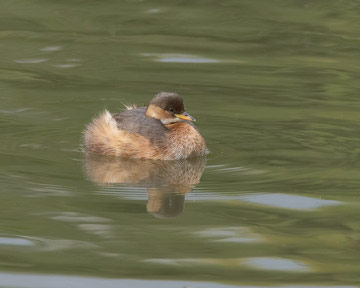
Little Grebe © Richard Steel
There is a clear shift in habitat and distribution of this species in winter. More than a century ago, Coward & Oldham (1900) noted that ‘The Little Grebe is widely distributed throughout the Cheshire lowlands in the breeding season, and in winter is often seen on waters where it does not nest. At this latter season, even when the ponds and meres are not frozen, it occurs on swift-flowing streams and rivers.’ This summary holds good today, and is well demonstrated by the habitat analysis. In the breeding season, there were 12 records on ponds and 50 on small waterbodies, 66 on lakes, meres and reservoirs with just five on rivers and canals; in winter there is some withdrawal from the smallest waters, with 6 on ponds and 43 using small waterbodies, with a major increase to 35 on linear watercourses, 23 on streams and rivers and 12 on canals. As Coward commented, there was no freezing weather to force the birds to move.
The winter map shows birds present in 72 tetrads that were empty in the breeding season, with an obvious increase especially on the Dee and Weaver, but they were recorded in only two estuarine tetrads: contrary to the suggestions from Vinicombe (1982) that birds breeding inland disperse to the coasts, there is no evidence for this in Cheshire and Wirral (or in the Migration Atlas). 85 tetrads were occupied in both seasons, with their early return to the breeding areas doubtless accounting for some of the ‘winter’ records, such as a pair trilling on Trentabank Reservoir (SJ97Q) on 29 January 2005. The 41 tetrads with breeding season presence that were unoccupied in winter were scattered across the county with no obvious pattern.
Anderson (1993) noted a decline in the wintering population of Little Grebes on the River Weaver in Nantwich, from figures of 12-31 in January to mid-March 1986 to counts of 4-6 in the same period of 1993. It was difficult to ascribe reasons for this, but the decline paralleled the arrival of Mink and the loss of Water Voles, although numbers of Moorhen and Mallard in the area were not affected. Up to 1986, double figure winter counts were recorded in CBRs from at least six sites, but since that year, no site other than the Weaver Bend had reported a double-figure count. This suggests a long-term and widespread drop in numbers. During this Atlas survey most counts were of just two birds and only three tetrads registered flocks larger than eight Little Grebes: 30 were counted at Frodsham Marsh (SJ57E) by Peter Twist in 2005/ 06, 22 at the north Wirral clay pits (SJ28P) were logged by Jeremy Bradshaw in 2004/ 05, and a maximum of 12 was present at Doddington Pool (SJ74D) in two winters.
Little Grebes are seldom seen on migration, and few are ringed, so the extent of immigration from the continent is unknown, but there are two foreign-ringed birds in winter elsewhere in Britain, from Denmark and Latvia. The maximum total WeBS counts account for only about one quarter of the supposed British and Irish breeding population, and many wintering birds must be on small waters and rivers not covered by WeBS.
Sponsored by Joe O'Hanlon

